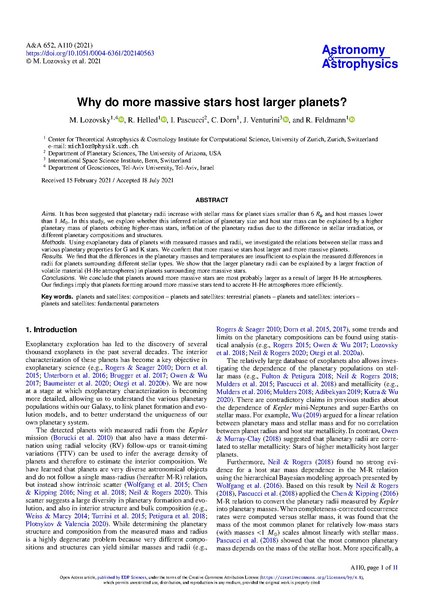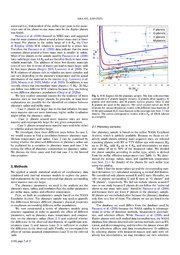File:Aa40563-21.pdf

Original file (1,239 × 1,752 pixels, file size: 328 KB, MIME type: application/pdf, 11 pages)
Captions
Captions
Summary
[edit]| DescriptionAa40563-21.pdf |
English: Aims. It has been suggested that planetary radii increase with stellar mass for planet sizes smaller than 6 R⊕ and host masses lower than 1 M⊙. In this study, we explore whether this inferred relation of planetary size and host star mass can be explained by a higher planetary mass of planets orbiting higher-mass stars, inflation of the planetary radius due to the difference in stellar irradiation, or different planetary compositions and structures.
Methods. Using exoplanetary data of planets with measured masses and radii, we investigated the relations between stellar mass and various planetary properties for G and K stars. We confirm that more massive stars host larger and more massive planets. Results. We find that the differences in the planetary masses and temperatures are insufficient to explain the measured differences in radii for planets surrounding different stellar types. We show that the larger planetary radii can be explained by a larger fraction of volatile material (H-He atmospheres) in planets surrounding more massive stars. Conclusions. We conclude that planets around more massive stars are most probably larger as a result of larger H-He atmospheres. Our findings imply that planets forming around more massive stars tend to accrete H-He atmospheres more efficiently. |
| Date | |
| Source |
https://www.aanda.org/articles/aa/full_html/2021/08/aa40563-21/aa40563-21.html https://doi.org/10.1051/0004-6361/202140563 |
| Author | M. Lozovsky, R. Helled, I. Pascucci, C. Dorn, J. Venturini and R. Feldmann |
Licensing
[edit]- You are free:
- to share – to copy, distribute and transmit the work
- to remix – to adapt the work
- Under the following conditions:
- attribution – You must give appropriate credit, provide a link to the license, and indicate if changes were made. You may do so in any reasonable manner, but not in any way that suggests the licensor endorses you or your use.
File history
Click on a date/time to view the file as it appeared at that time.
| Date/Time | Thumbnail | Dimensions | User | Comment | |
|---|---|---|---|---|---|
| current | 14:39, 1 September 2021 |  | 1,239 × 1,752, 11 pages (328 KB) | Pamputt (talk | contribs) | Uploaded a work by M. Lozovsky, R. Helled, I. Pascucci, C. Dorn, J. Venturini and R. Feldmann from https://www.aanda.org/articles/aa/full_html/2021/08/aa40563-21/aa40563-21.html https://doi.org/10.1051/0004-6361/202140563 with UploadWizard |
You cannot overwrite this file.
File usage on Commons
There are no pages that use this file.
Metadata
This file contains additional information such as Exif metadata which may have been added by the digital camera, scanner, or software program used to create or digitize it. If the file has been modified from its original state, some details such as the timestamp may not fully reflect those of the original file. The timestamp is only as accurate as the clock in the camera, and it may be completely wrong.
| Short title | Why do more massive stars host larger planets? |
|---|---|
| Image title | A\&A 652, A110 (2021). DOI: 10.1051/0004-6361/202140563 |
| Author | Lozovsky M., Helled R., Pascucci I., Dorn C., Venturini J., Feldmann R. |
| Keywords |
|
| Software used | LaTeX with hyperref package |
| Conversion program | pdfTeX-1.40.18 |
| Encrypted | no |
| Page size | 595.276 x 841.89 pts (A4) |
| Version of PDF format | 1.3 |
